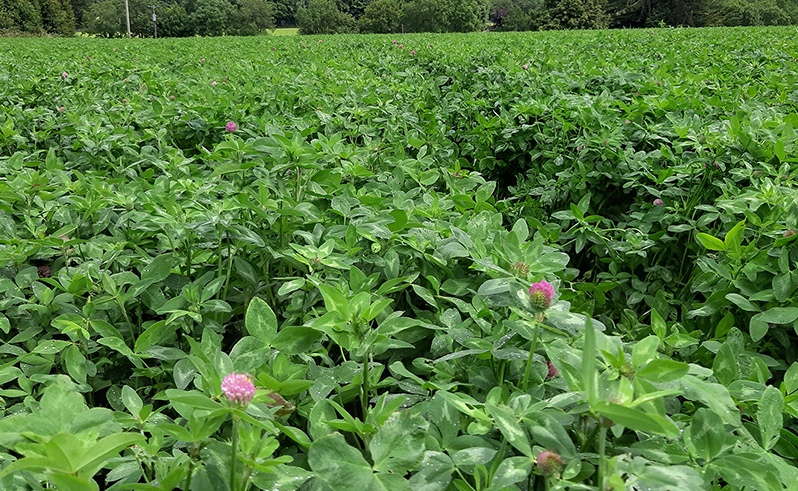Managing Red Clover

Clover plants are high in protein and therefore can reduce the need for bought in feed. Some farmers are now growing exclusively red clover swards for both conservation and as a high protein finishing feedstuff which can be fed in-situ, but correct management must be employed to maximise its’ productivity.
How to manage red clover:
Red clover needs careful management as it grows from a crown just above ground level, poor management will lead to this crown getting damaged and subsequently dying out of the sward. In a grazing situation, it must be remembered to leave slightly higher residuals (6-8cm) than with a grass ley. The same theory should be applied where conservation cuts are being taken on red clover swards. Red clover silage is a highly digestible and protein rich feedstuff, the aim should be to minimise turning before ensiling. Research has shown that as much as 5% of protein is lost with every turning of the crop where red clover dry matter (DM) levels are in excess of 30% (>30%DM). This can be attributed to ‘leaf shatter’ caused by the physical movement on the crop whilst wilting
Red clover is primarily grown in a mixed sward, but increasingly it is being grown as a monoculture. Italian ryegrass, Hybrid ryegrass and Perennial ryegrass can all be sown as a companion species with red clover – it is advised to sow recommended varieties that are available from Drummonds.
Adding grass to the mix will enable greater carrying capacity, reduce poaching and crown damage to the red clover as well as improve the nutritional value of the sward.
Home grown protein:
Red clover swards are generally grown for high protein silage production, with aftermath grazing in the autumn. In terms of output, 10 -15 t/DM per hectare is achievable from red clover and companion grass swards but good where soil indices and pH levels are fundamental to this. Crude protein content of red clover & ryegrass swards can be 5% - 6% higher than that of a pure ryegrass sward, allowing for increased animal performance.
Ruminants are often revered as poor users of protein but red clover can have a positive impact on this. ‘Bypass protein’ is a term often associated with red clover. Natural compounds (Polyphenol oxidase) within the red clover plant envelope protein compounds whilst in the rumen but these compounds are then broken down when they enter the ‘true stomach’ or abomasum where the pH is slightly lower. This allows for better utilisation of available protein.
Animal health:
Farmers should be wary of bloat when grazing stock on clovers in general. Bloat can be linked to protein degradation in the digestive tract of the animal and can cause a build-up of gases in the digestive tract. Correct pasture allocations and a sufficient fibre content in the diet normally keep bloat at bay in herds and flocks but it should be taken into consideration.
When fed in-situ, red clover can negatively affect the fertility of female breeding stock. For sheep, the advice is not to graze the ewes on red clover based swards (more than 25% DM red clover) six weeks either side of going to the ram. Natural phyto-oestrogens contained within the plant interfere with the reproductive tract. The impact of grazing red clover resolves itself within a month of being removed from the crop, but sheep producers need to be extra vigilant. As the weaning period encroaches, red clover leys should be prioritised for the growing/finishing lambs. It is thought the ‘clover infertility’ is not as prominent from red clover silage – but farmers should take it into consideration.
Animal performance:
Using red clover can improve animal production due to its high nutritional value and superior digestibility, thus, leading to increased animal intakes.
Trials in AFBI show an increased dry matter intake of 1.6kg/DM day where cows were offered red clover/PRG silage vs. PRG silage only. Grazing trials have also shown a 25% increase in the daily growth rate of weaned lambs grazing red clover versus than ryegrass swards, resulting in fewer days to finishing.
Establishing red clover:
Red clover performs best in warm soils. Aim to sow when soil temperature is at least 10 °C.
For monoculture swards use 6kg/acre
For mixed swards use 3kg/acre of red clover and 10kg/acre of grass
Post emergence broad leaved weed spraying is not an option where red clover is in a sward. Ideally old swards should be sprayed off and given adequate time to die away before reseeding. Ploughing or minimum cultivation techniques can be used but a fine, firm seedbed should always be the goal.
Alternatively, perennial ryegrass can be sown in Spring with broad leaved weeds being sprayed out before stitching in red clover at a later stage.
SOWING TIPS:
- A clean, firm seedbed, ring-rolled prior to sowing
- Soil pH of 6.0-6.5. Any lime applied to correct pH should be done well in - advance of sowing
- Apply fertiliser accordingly. Heavy applications of Nitrogen are not advisable as competition from companion species is increased. The plants ability to fix atmospheric Nitrogen is also reduced where bagged Nitrogen is applied.
- -Red clover should be sown into warm soil (8-10 °C) from April to late July.
.
|
SOWING INFORMATION Sowing time: April/May – August Sowing rate: 2 - 3 kg/acre (plus 10-12 kg companion species grass) 6 kg/acre (monoculture) |
YIELD & FEED QUALITY (Grass plus white clover) Average DM yield: 12 – 14 tonne DM/ha Dry Matter: 12 – 15% Crude protein: 20-25% Digestibility: 72+ % (DMD) Metabolisable energy: 10 – 11.5 Mj/kg DM |
